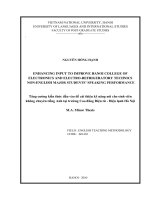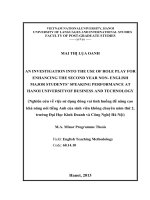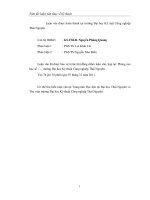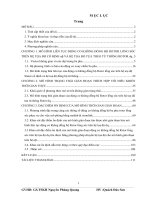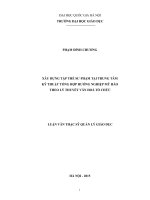(Luận văn thạc sĩ) effectiveness of implementing the genre approach on non english major students’ writing performance at university of social sciences and humanities
Bạn đang xem bản rút gọn của tài liệu. Xem và tải ngay bản đầy đủ của tài liệu tại đây (2.01 MB, 108 trang )
VIET NAM NATIONAL UNIVERSITY-HA NOI
UNIVERSITY OF LANGUAGE & INTERNATIONAL STUDIES
FACULTY OF POST – GRADUATE STUDIES
*****************
TÔ THỊ MAI
EFFECTIVENESS OF IMPLEMENTING THE GENRE
APPROACH ON NON-ENGLISH MAJOR STUDENTS’
WRITING PERFORMANCE AT UNIVERSITY OF
SOCIAL SCIENCES AND HUMANITIES
(HIỆU QUẢ ỨNG DỤNG ĐỊNH HƯỚNG DẠY VIẾT THEO THỂ LOẠI ĐỐI
VỚI KHẢ NĂNG VIẾT CỦA SINH VIÊN KHÔNG CHUYÊN TIẾNG ANH TẠI
TRƯỜNG ĐẠI HỌC KHOA HỌC XÃ HỘI VÀ NHÂN VĂN)
M.A. COMBINED PROGRAMME THESIS
Field: English Teaching Methodology
Code: 60140111
Hanoi – 2015
VIET NAM NATIONAL UNIVERSITY-HA NOI
UNIVERSITY OF LANGUAGE & INTERNATIONAL STUDIES
FACULTY OF POST – GRADUATE STUDIES
*****************
TÔ THỊ MAI
EFFECTIVENESS OF IMPLEMENTING THE GENRE
APPROACH ON NON-ENGLISH MAJOR STUDENTS’
WRITING PERFORMANCE AT UNIVERSITY OF
SOCIAL SCIENCES AND HUMANITIES
(HIỆU QUẢ ỨNG DỤNG ĐỊNH HƯỚNG DẠY VIẾT THEO THỂ LOẠI ĐỐI
VỚI KHẢ NĂNG VIẾT CỦA SINH VIÊN KHÔNG CHUYÊN TIẾNG ANH TẠI
TRƯỜNG ĐẠI HỌC KHOA HỌC XÃ HỘI VÀ NHÂN VĂN)
M.A. COMBINED PROGRAMME THESIS
Field: English Teaching Methodology
Code: 60140111
Supervisor: Dr. Prof. Hoàng Văn Vân
Hanoi – 2015
DECLARATION
I hereby declare that the minor thesis entitled “Effectiveness of implementing the
genre approach on non-English major students’ writing performance at University of
Social Sciences and Humanities” is the result of my own work and effort in partial
fulfillment of the requirements for the degree of Master of Arts at Faculty of PostGraduate Studies, Hanoi University of Languages and International Studies,
Vietnam National University. The material in this research has not been submitted
to any other university or institution wholly and partially.
Hanoi, 2015
Tô Thị Mai
i
ACKNOWLEDGEMENTS
I am indebted to many people without whose help my thesis could not have
been completed. First of all, I would like to express my sincere gratitude to my
supervisor Prof. Dr. Hoang Van Van for his invaluable guidance, insightful comments
and endless support.
I wish to express my deep indebtedness to Assoc. Prof. Dr. Lam Quang Dong,
Dean of the Faculty of English, University of Languages and International Studies
(ULIS) for his great encouragement to me. Also, my special thanks are due to Ms. Lai
Phuong Thao, Vice Dean of the Faculty of English University of Languages and
International Studies (ULIS) and Ms. Lam Thi Hoa Binh, Head of English Devision at
University of Social Sciences and Humanity (USSH) for their kind assistance and
valuable suggestions.
My thanks are also extended to all my student informants at USSH, my
colleagues at ULIS and USSH, and all the people who have assisted my research work.
To all mentioned, and to many more, my heart extends the warmest thanks.
ii
ABSTRACT
The effectiveness of genre-based approaches to teaching writing has been
widely acknowledged in a large number of experimental and theoretical studies;
however, any detailed examination of this effectiveness on both students’ writing
performance and their attitudes towards writing in light of genre approaches is still
limited. This study is an attempt to provide empirical evidence of the effectiveness of
the genre-based approach in enhancing both the writing performance and attitudes
towards writing of non-English majored students at University of Social Sciences and
Humanities, Hanoi. The study lasted 10 weeks, adopted the quasi-experimental design
with one control group and one experimental group and used the writing pre-test/posttest and attitude pre-scale/post-scale instruments. The results show that the genre-based
approach helped students improve their writing performance in terms of content,
communicative achievement and organisation, while their command of language did
not show remarkable improvement. Furthermore, the findings also reveal more positive
attitudes of students towards learning writing when being taught in the genre-based
approach. Based on those findings, the thesis provides some implications for using the
genre-based approach in teaching writing to low level students at university.
iii
TABLE OF CONTENTS
ACKNOWLEDGEMENTS .......................................................................................... ii
ABSTRACT ................................................................................................................iii
TABLE OF CONTENTS ............................................................................................ iv
LIST OF TABLES AND FIGURES.............................................................................viii
ABBREVIATIONS AND CONVENTIONS ............................................................... ix
PART A...........................................................................................................................1
INTRODUCTION .........................................................................................................1
1. Rationale for the study ..............................................................................................1
2. Aims of the study .......................................................................................................3
3. Research questions ......................... ..........................................................................3
4. Scope of the study ......................................................................................................3
5. Methods of the study .................................................................................................4
5.1. Research method .............................................................................................. 4
5.2. Research instruments ........................................................................................ 4
5.3. Data collection .................................................................................................. 4
5.4. Data analyis .................................................................................................... 5
6. Design of the study.................................................................................................. 6
PART B ....................................................................................................................... 7
DEVELOPMENT ...................................................................................................... 7
CHAPTER 1 ..................................................................................................................7
LITERATURE REVIEW .............................................................................................7
1.1. Theoretical background.......................................................................................7
1.1.1. Different approaches to teaching writing .....................................................7
1.1.1.1. Product approach ................................................................................... 7
1.1.1.2.Process approach ..................................................................................... 8
1.1.1.3. Genre approach........................................................................................10
1.1.1.3.1. The concept of “genre” ................................................................. 10
1.1.1.3.2. Application of the genre approach .................................................. 12
1.1.1.3.3. Merits of the genre approach ............................................................18
iv
1.1.1.3.4. Comparison among the product, process and genre approaches.......20
1.1.2. Theory of recount writing .........................................................................
25
1.1.2.1. Definition of recount ..........................................................................25
1.1.2.2. Generic concepts of recount.................................................................26
1.1.2.3. Grammatical features of recount ....................................................... 26
1.1.2.4. Types of recount...................................................................................26
1.1.3. Corrective feedback and writing assessment................................................27
1.1.3.1. Corrective feedback .........................................................................27
1.1.3.1.1. Feedback in the Product Approach.................................................. 27
1.1.3.1.2. Feedback in the process approach ................................................... 28
1.1.3.1.3. Feedback in the genre approach ...................................................... 28
1.1.3.2. Writing Assessment ............................................................................ 29
1.1.4. Writing performance and writing attitude....................................................31
1.2. Related studies....................................................................................................32
1.2.1. Effectiveness of genre-based approaches ....................................................32
1.2.2. Limitations of previous studies ............................................................. .... 36
CHAPTER TWO ...................................................................................................... 38
METHODOLOGY ................................................................................................... 38
2.1. Research design .............................................................................................. 38
2.2. Setting and participants .................................................................................. 39
2.3. Instruments ..................................................................................................... 41
2.3.1. Genre-based approach syllabus of recount genre........................................41
2.3.2. Written English performance pre-test and post-test ................................. 41
2.3.3. Analytical scoring rubric ........................................................................... 42
2.3.4. Pre-scale and post-scale attitude questionnaires ....................................... 45
2.4. Lesson procedure ............................................................................................ 46
2.4.1. Lesson procedure in the genre-based approach ..........................................46
2.4.1.1. Building up the field knowledge.............................................................46
2.4.1.2. Modelling the text...................................................................................47
2.4.1.3. Joint construction of a new text..............................................................48
v
2.4.1.4. Independent construction of a new text..................................................48
2.4.2. Lesson procedure in the process approach .................................................46
2.4.1.1. Lesson 1..................................................................................................46
2.4.2.2. Lesson 2 .................................................................................................47
2.4.1.3. Lesson 3..................................................................................................47
2.4.2.4. Lesson 5 .................................................................................................47
2.4.1.5. Lesson 6..................................................................................................47
2.4.2.6. Lesson 7 .................................................................................................47
2.4.1.7. Lesson 7..................................................................................................47
2.4.2.8. Lesson 8 .................................................................................................48
2.5. Data collection ...................................................................................................51
2.6. Data analysis ................................................................................................... 52
2.6.1. Pre-test and post-test ................................................................................. 52
2.6.2. Pre-scale and post-scale attitude questionnaire ..........................................52
CHAPTER THREE.................................................................................................. 54
RESULTS AND DISCUSSION ..................................................................................54
3.1. Equivalence of the control and experimental groups
before the experiment ........................................................................................... 54
3.2. Findings .............................................................................................................58
3.2.1. Research question 1 .....................................................................................58
3.2.1.1. Differences between experimental and control groups on the writing
performance ...................................................................................................... ..58
3.2.1.2. Differences in the experimental group on the writing performance preand post-test............................................................................................................60
3.2.2. Research question 2............................................................................... ....63
3.3 Discussion ......................................................................................................65
3.3.1. Effectiveness of the genre-based approach in improving writing
performance.......................................................................................................65
3.3.2. Effectiveness of the genre-based approach
in promoting students’ attitudes........................................................................67
vi
PART C ...................................................................................................................... .69
CONCLUSION ......................................................................................................... 69
1. Recapitulation ....................................................................................................... 69
2. Implications of the study .........................................................................................70
3. Limitations of the study .........................................................................................71
4. Recommendations for further research ................................................................72
REFERENCES ............................................................................................................74
APPENDIXES ................................................................................................................I
vii
ABBREVIATIONS AND CONVENTIONS
EFL
English as a Foreign Language
USSH
University of Social Sciences and Humanities
CEFR
The Common European Framework of Reference for
Languages
ESOL
English for Speakers of Other Languages
EFL
English as a foreign language
&
and
N
number
α
significance level (a term used in SPSS)
t
t value (a term used in SPSS)
df
degree of freedom (a term used in SPSS)
sig.
significance (a term used in SPSS)
viii
LIST OF FIGURES AND TABLES
Figure1: The model of process writing ................................................................................9
Figure 2: Genre processes…………………………………………………………………12
Figure 3: Teaching and learning cycle in genre approaches ...............................................13
Figure 4: Procedure for a genre-based lesson .....................................................................15
Figure 5: Comparison between the process and the genre approaches ...............................21
Table 1: T-test results of the writing pre-test comparing both control and experimental
groups in overall writing performance…………………………………………………….54
Table 2: T-test results of the writing pre-test comparing both control
and experimental groups in Content……………………………………………………….55
Table 3: T-test results of the writing pre-test comparing both control and experimental
groups in Communicative Achievement ………………………………………………….55
Table 4: T-test results of the writing pre-test comparing both control and experimental
groups in Organisation…………………………………………………………………….56
Table 5: T-test results of the writing pre-test comparing both control and experimental
groups in Language ……………………………………………………………………….56
Table 6: T-test results of pre-scale attitude scores between the control and experimental
groups…………………………………………………………………………………….. 57
Table 7: The t-test results of the writing post-test for overall writing performance ……..58
Table 8: The t-test results of the writing post-test in components of writing erformance...59
Table 9: The t-test results of the writing pre-post-test in overall writing performance…..61
Table 10: T-test results of the writing pre-post-tests of the experimental group………….62
Table 11: The t-test results of the attitude post-scale comparing both control and
perimental groups …………………………………………………………………………63
Table 12: T-test results of the attitude pre-post-scale for the experimental group.......64
ix
PART A: INTRODUCTION
1. Rationale for the study
There has been a well-established acknowledgement that writing is of
paramount importance in English as a Foreign Language (EFL). According to
Hoang Van Van (2010), writing helps learners to study better because while
writing, learners consolidate their grammatical knowledge and develop their use
of language, have opportunities to employ what they have studied, and pay
particular attention to express their ideas by frequently using their eyes, hands
and brains; as a result, the close relation between writing and cognitive
development makes writing an essential component of any English language
programs.
In assertion about the role of writing, there have been a range of dramatic
changes in writing pedagogy in the last two decades, leading to paradigm shifts
from product-based to process-based and then to genre-based approaches. This
calls for practitioners’ search for and implementation of a more coherent,
comprehensive approach to the teaching of writing.
However, writing is still perceived as the most difficult skill to practise
for both professional writers and language learners. For example, Raimes (1985)
observed the difficulties which her students experienced when performing a
writing assignment: they "chew their pencils, shuffle their feet, sigh, groan and
stretch." Therefore, a number of teachers of English believe that teaching writing
skill to EFL learners is more complex than teaching other communicative skills
(Mazdayasna & Tahririan, 2001) and EFL learners often feel stressful and
anxious when writing in a foreign language (Spratt & Leung, 2000).
In the case of Vietnam, writing classes in universities nowadays are still
predominantly language-based writing classes that focus on sentence writing for
sentence building tests, rather than focusing on creating compositions to serve
the purpose of plurality of real readers outside the classroom context. Also, the
negative attitude from both teachers and learners has been escalating, especially
in the situation of students’ low results of writing tests at University of Social
1
Sciences and Humanities (USSH) in 2012 and in 2013. In fact, there has been
insufficient time allocation for writing, accounting for only 12-14 class hours out
of 90 class hours in the syllabus. Under this time constraint, a majority of
teachers were observed to adopt the process approach to teaching writing, while
some of them chose the product approach, and the manipulation of the lexicogrammatical information takes precedence over demonstration of writing skills.
On one hand, the process approach to writing neglects the “socio-cultural
context” of writing (Horowitz, 1986). On the other hand, the product approach
has been criticized for being pedagogically weak owing to the insufficient
attention it paid to the writing stages (Freedman, 1983). Moreover, it is argued
that when the student-writer manipulates the linguistic components of writing,
they do no more than “lock themselves into a semantic and rhetorical prison”
(Raimes, 1983). Thus, the effects of these writing instructions on students’
writing at USSH have not been remarkable.
Moreover, students at USSH have been studying writing skills based on
the coursebook “New English File, by Clive Oxenden and Christina LathamKoenig, Oxford Univeristy Press, 2010 to be qualified for B1-level according to
The Common European Framework of Reference for Languages (CEFR).
However, the separated activities from the coursebook have been found
inadequate to foster the learners’ writing skill. Consequently, students
limitations on grammatical knowledge affect accuracy, and many of them show
hesitation on writing. These confronting problems urge the researcher to
investigate for a more practical instruction assisting and guiding students how to
write more effectively.
Meanwhile, the genre-based approach is confirmed to be effective in a
variety of studies by Henry and Roseberry (1998), Burns (2001), Hyland (2002),
Swale (2004), Kim and Kim (2005), Matsuo and Bevan (2006), Cheng (2007),
Chaisiri (2010), Lai and Tseng (2012), Elashri (2013), and Alidoost et al (2014)
. However, the body of research on the application of genre-based approach to
teaching writing in Vietnam in general is still limited with only few studies by
Luu Trong Tuan (2011) and Trinh Quoc Lap and Nguyen Thanh Truc (2014).
2
Studies that can be applicable to USSH situation are even harder to find. This
research “Effects of implementing a genre-based approach on non-English
majored students' writing performance at University of Social Sciences and
Humanities, Hanoi” was, therefore, conducted with the hope of examining the
impacts of adopting the genre-based approach on writing performance of
students at USSH.
2. Aims of the study
This study aims at providing empirical evidence of whether there is any
effectiveness of the genre-based approach in enhancing both the writing
performance and attitudes towards writing of students at USSH.
3. Research questions
This research is guided by two ensuing questions:
Research question 1:
What is the difference of using the genre-based approach in improving
non-English majored students’ writing performance at USSH?
Research question 2:
What is the difference of using the genre-based approach in promoting
students’ positive attitudes towards writing at USSH?
4. Scope of the study
Due to the time limit, the researcher only studied on a limited sample of
60 students at USSH. These students were in the second year at USSH and of
pre-intermediate English levels.
Furthermore, it was impossible to cover all genres in this writing course;
hence, the researcher only chose recount genre to carry out the genre instruction
in the experimental group.
3
5. Methods of the study
5.1 Research method
The study was designed as a quasi-experimental research through the use
of the control group and the experimental group. The independent variable was
genre-based instruction, and the dependent variable was students’ writing
achievement.
The measurements included a pre-test and a post-test in writing; a prescale attitude questionnaire and a post-scale attitude questionnaire.
5.2 Research instruments
The following instruments were used for the study:
- A recount genre-based writing syllabus covering recount genre.
- Written English performance pre-test and post-test.
-
An
analytical
scoring
rubric
covering
four
parameters:
Content,
Communicative Achievement, Organisation and Language to assess students’
writing performance. The score range in each parameter was 1 up to 5, which
means the minimal score was 4 and the maximum score was 20.
- Pre-scale and post-scale attitude questionnaires before and after the treatment
to investigate any changes in students’ perceptions of writing.
5.3 Data collection
The data are collected mainly from two tests, the pre-test and post-test of
students’ writing performance and two scales, the pre-scale and post-scale
attitude questionnaires. Before the treatment of the genre-based writing
instruction to the experimental group and the process-based writing instruction
to control group, the pre-test was given to all participants.
The participants for this study were 60 students (58 females and 2 males)
who were randomly selected from over 100 volunteers to participate in the
4
experiment. However, in order to be qualified to take part in the course, they had
had to pass A2-level (CEFR) exams at USSH.
Participants took the pre-test to have scores of their writings. In the pretest, the participants wrote one simple writing in the form of a story based on
their prior knowledge. At the same time, they were given pre-attitude
questionnaires to scale their perceptions upon writing ability.
After that, they were randomly assigned into two classes; one of the class
(30 students) was randomly selected as the control group and the other class (30
students) as the experimental group.
Next, the experimental group were taught by using the genre-based
approach for ten meetings; meanwhile, the control group were taught in the
process-based approach. After the treatment, the post-test, with the same writing
question as that of the pre-test, was given to two groups, but the researcher asked
them to create new writing products using the knowledge they had learnt after
the course. Finally, the post-attitude questionnaires were delivered again to both
two groups to collect their perceptions of learning writing after the treatment.
5.4 Data analyis
In analyzing data, descriptive statistics test was used to calculate the
participants’ writing performance in the pre-test and the post-test of the two
groups. Then, the researcher applied the T-Test formula to compare the results of
the mean differences in the writing performance of participants in two groups
and in their attitudes about writing.
5
6. Design of the study
The study is composed of three parts.
Part A: Introduction
This part presents an overview of the study including rationale, aims,
research questions and hypothesis, scope of the study as well as the
methodology for the research.
Part B: Development
This is the main part which consists of three chapters:
Chapter one: Literature Review
This chapter provides the theoretical background for the research
as well as reviews related studies in the literature. This helps to establish a
framework of investigation in this study.
Chapter two: Methodology
This chapter presents the research method employed in the study in
detail with a hope of reasoning its relevance to the study and the
procedure of selecting the sample, conducting the experiment, and
collecting and analyzing data.
Chapter three: Results and Discussion
This chapter deals with the findings of the study in accordance
with two guiding research questions and four hypotheses. From the
results, the researcher discusses some consistency and inconsistency with
previous studies. It also puts forward some suggestions for the teaching of
English writing at university level.
Part C: Conclusion
The final part presents a recapitulation of the study, implication of the
study, limitations of the study, and recommendations for further research.
6
PART B: DEVELOPMENT
CHAPTER 1: LITERATURE REVIEW
1.1. Theoretical background
1.1.1. Different approaches to teaching writing
1.1.1.1. Product approach
During the audiolingualism era, the role of writing was downplayed as
only a supporting skill; hence, writing classes only focused on sentence
structures as a support for the grammar class. As stated by Silva (1990), the
product approach was used in order to highlight form and syntax and the
emphasis was on rhetorical drills.
Explicitly, Badger and White (2000:154) viewed writing as “mainly
concerned with the knowledge about the structure of language, and writing
development is mainly the result of the imitation of input, in the form of texts
provided by the teacher”. Generally the focus of such writing is on the written
product rather than on how the learner addresses the process of writing. This
approach, therefore, is teacher-centred, as the teacher becomes the arbiter of the
models used.
In this approach, learning to write has four stages: familiarization;
controlled
writing;
guided
writing;
and
free
writing.
First, the
familiarization stage aims to make learners aware of certain features of a
particular text. Next, in the controlled and guided writing sections, the
learners practise the skills with increasing freedom until they are ready for
the free writing section.
Proponents of this product approach argue that it enhances students’
writing proficiency since it recognizes the need for learners to be given linguistic
knowledge about texts, and it understands that imitation is one way in which
7
people learn. Myles (2002) insisted, “If students are not exposed to native-like
models of written texts, their errors in writing are more likely to persist.”
Nonetheless, this approach is criticised for many weaknesses. According
to Prodromou (1995), the product approach devalues “the learners’ potential,
both linguistic and personal.” In this approach, the process skill such as planning
a text is given a relatively small role, and the knowledge and skills that learners
bring to the classroom are undervalued.
In short, product-based approaches see writing as mainly concerned with
knowledge about the structure of language, and writing development as mainly
the result of the imitation of input, in the form of texts provided by the teacher.
The weaknesses of this approach led to the re-assessment of writing nature and
the pedagogy in which it is taught, the shift to writing as process.
1.1.1.2. Process approach
To compensate for the product approach, process approach views writing
as predominantly doing with linguistic skills, such as planning and drafting, and
there is much less emphasis on linguistic knowledge, such as knowledge about
grammar and text structure. Tribble (1996) suggests that process approaches
stress writing activities which move learners from the generation of ideas and the
collection of data through to the publication of a finished text.
There are different views on the stages of producing a piece of writing,
but a typical model identifies a recursive procedure of four steps: prewriting;
composing/drafting; revising; and editing (Tribble, 1996). The following is a
diagram taken from Tribble (1996), illustrating the recursive and unpredictable
process of writing.
8
Figure 1: The model of process writing
(Source: Tribble, 1996)
According to the process approach, in pre-writing, teachers would
introduce techniques that help students discover and engage a topic. Instead of
turning in a finished product right away, students are asked for multiple drafts of
a work. After discussion and feedback from readers, the students would revise
the drafts. Rewriting and revision are indispensable to writing, and editing is an
ongoing multilevel process. In this model, the primary elements are the writer,
the content and the purpose, and multiple drafts.
In process approaches, the teacher is primarily a facilitator in the learners’
writing, and providing input or stimulus is considered to be less important.
The main advantages of the process approach are it understands the
importance of the skills involved in writing, and recognizes that what learners
bring to the writing classroom contributes to the development of writing ability.
However, the process approach also has come under serious scrutiny
because it has a somewhat monolithic view of writing (Badger and White, 2000).
Regardless of the target audience and the content of the text, all writings are
produced by the same set of processes. In addition, it gives insufficient
importance to the kind of texts writers produce and why such texts are
9
produced; and that it offers learners insufficient input, particularly in terms
of linguistic knowledge, to write successfully.
Moreover, the process approach seems to narrowly focus on the skills and
processes of writing in the classroom itself; consequently, it fails to take into
account the social and cultural aspects that have an impact on different kinds of
writing (Atkinson, 2003).
1.1.1.3. Genre approach
1.1.1.3.1. The concept of “genre”
From the perspective of systemic-functional linguistics, people do not
merely write so as to express their own unique ideas born of nowhere. As social
members of a community, they create texts which conform to social norms
depending on a number of contextual factors such as targeted audience, writing
purpose, and discourse environment. It is these rules that determine appropriate
language and text organization in each occurrence. In this regard, the notion
of genre has become central to teaching and learning EFL writing.
Swales (1990:58) perceived a genre as “a class of communicative events,
the members of which share some set of communicative purposes”. This
definition offers the fundamental concept that there are certain conventions
which are generally involved with a writer’s communicative purpose. For
example, a personal letter tells about the writers’ private anecdotes, and a
personal letter starts with a cordial question in a friendly mood because its
purpose is to maintain good relationships with friends.
According to Hyland (2007:4), “genre is a term for grouping texts
together, representing how writers typically use language to respond to recurring
situations.” In line with this definition, Nunan (1999:308) also stated:
“Genre is a purposeful, socially constructed oral or written
communicative event, such as narrative, a casual conversation, a
10
poem, a recipe, or a description. Different genres are characterized by
a particular structure or stages, and grammatical forms that reflect the
communicative purpose of the genre in question.”
The communicative purposes of the text determine the linguistic inputs of
the text, often in form of structural features as mentioned above. The structural
features that genres are constituted of comprise both standards of organization
structure and linguistic features. Standards of organizational structure refer to
how the text is sequenced. As regards linguistic features, their common sets can
make up a text type, a class of texts having similarities in linguistic forms
irrespective of the genre. Each text type, such as news report, letter, email,
interview, promotional leaflet, newspaper article, encodes the purposes and
meanings of the social institutions of a cultural milieu. Text types are
characterized by a relatively stable structural order (beginnings, middles and
ends), a consistent way of organizing information (in paragraphs, in bullet
points, sections), and lexicogrammatical features and structures that materially
articulate the social purpose of each text.
The language features of a text give shape to and are shaped by its course
of linguistic input. They are usefully organized into five basic generic processes
by Knapp and Watkins (2005) (see Figure 2). Each one of these processes
demands the use of different text organization and different lexicogrammar.
However, Gibbons (2002:53) simply refers to ‘genre’ as different forms
of writing and the term ‘genre’ encompasses a broad range of texts, from
transactional writing to narrative, descriptive, expository, procedural and
argumentative. Each genre has characteristics that distinguish it from other
genres. It has a specific purpose, overall structure and linguistic features that are
recognised by members of a specific culture.
11
GENRES
SOCIAL PROCESSES THAT:
DESCRIBE
EXPLAIN
INSTRUCT
through the
process of
ordering things
into
commonsense
or technical
frameworks of
meaning.
through the
process of
sequencing
phenomena in
temporal and/or
causal
relationships.
through the
process of
logically
sequencing
actions or
behaviours.
Personal
descriptions
Explanations of
how
Procedures
Essays
Instructions
Expositions
Commonsense
descriptions
Explanations of
why
Manuals
Discussions
Technical
descriptions
Elaborations
Recipes
Debates
Directions
Interpretations
Information
reports
Scientific
reports
ARGUE
through the
process of
expanding a
proposition to
persuade
readers to
accept a point of
view
COMMONLY USED IN
Illustrations
Evaluations
Accounts
Explanation
Essays
NARRATE
through the
process of
sequencing
people and
events in time
and space.
Personal
recounts
Historical
recounts
Stories
Fairy tales
Myths
Fables
Narratives
Definitions
Figure 2: Genre processes
(Source: Knapp and Watkins, 2005:27)
Confronted with a variety of conception about “genre” above, the
researcher, in this study, opts to adopt the notions of “genre” by Hyland (2007:4)
and Nunan (1999:308) as presented above because their concepts reflect the
comprehensible theory to apply genre approaches to teaching and learning
writing in the research situation.
1.1.1.3.2. Application of the genre approach
The introduction of genre pedagogies is a response to the still widespread
emphasis on a planning-writing-reviewing framework which focuses learners on
strategies for writing rather than on the linguistic resources they need to express
themselves effectively.
12
Martin (1992) defines the teaching of genres as a goal-orientated process
that is conducted through stages which are each characterised by purposeful
activities that ultimately allow learners to become engaging members of the
target discourse community.
Teaching and learning cycle in genre approaches
Hyland (2003:22) shows the teaching-learning cycle model in the genre
approach (see Figure 3). It includes three stages: modelling, joint construction
and independent construction of a text:
Figure 3: Teaching and learning cycle in genre approaches
(Source: Hyland, 2003:22)
Each of these stages seeks to achieve a different purpose, and as a result,
is associated with different types of classroom activities and different teacherlearner roles (Hyland, 2004).
The cycle is one way of understanding the Five E’s concept long familiar
in science teaching, helping learners to engage, explore, explain, extend, and
evaluate (Trowbridge & Bybee, 1990). The cycle is intended to be used flexibly,
13
allowing students to enter at any stage depending on their existing knowledge of
the genre and to enable teachers to return to earlier stages of the cycle for
revision purposes.
The key purpose of the cycle is to ensure repeated opportunities for
students to engage in activities which require them to reflect on and critique their
learning by developing understandings of texts, acting on these through writing
or speaking, reviewing their performance, and using feedback to improve their
work. The model, therefore, allows vocabulary to be recycled and the literacy
skills gained in previous cycles to be further developed by working through a
new cycle at a more advanced level of expression of the genre.
Later, Widodo (2006) proposed a procedure for the genre-based lesson
including two main teaching-learning cycles in standard genre-based writing
teaching: writing with the class and writing independently. Each of these cycles
has associated activities.
Writing with the class involves:
(1) building knowledge of the field,
(2) exploring the genre,
(3) joint text construction,
Writing independently includes:
(1) building knowledge of a similar field,
(2) drafting, revising, and conferencing,
(3) editing and publishing.
Each stage has different purposes in terms of the writing process. Such a
genre-based writing cycle can be illustrated in Figure 4 below:
14

